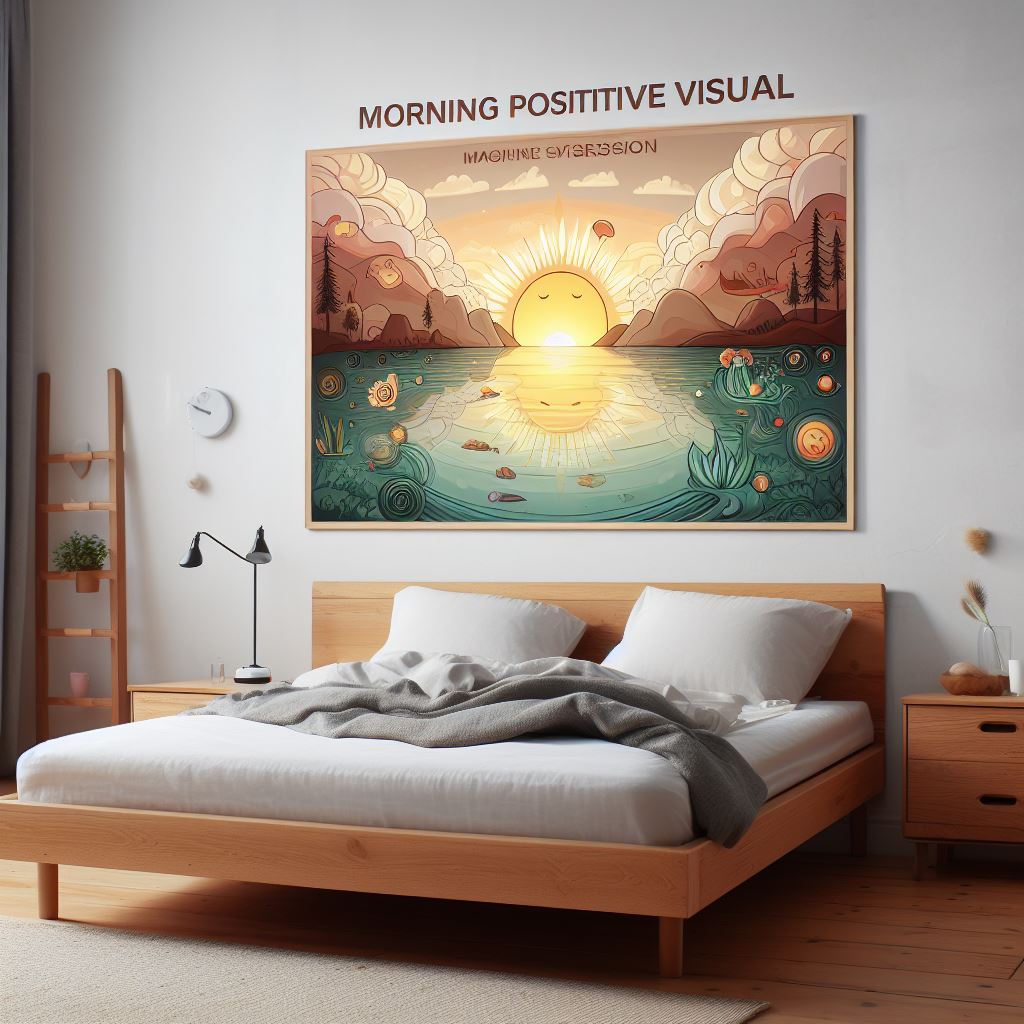In today’s fast-paced world, it’s crucial to find effective stress reduction strategies. How does visualization promote relaxation and stress reduction?
This guide explores the transformative potential of visualization—a powerful mental technique for achieving relaxation and inner peace.
As we journey together, you’ll uncover the science and practical applications of visualization.
Each section equips you with actionable insights, from understanding the science behind it to mastering techniques like creative imagery and guided visualization.
The benefits extend beyond stress reduction, including improved sleep and heightened self-confidence.
We’ll also explore visualization’s holistic impact, versatile applications, and its synergy with mindfulness.
By the end of this article, you’ll possess the tools to embark on a journey toward a calmer, more centered, and stress-free life. Welcome to the world of visualization, where your mind’s power can promote relaxation and resilience.
What is Visualization?
Visualization is a mental practice that involves harnessing the power of imagination to create vivid mental images and scenarios.
It’s a technique where you use your mind’s eye to construct detailed mental representations of situations, places, or desired outcomes, as if they were real and happening in the present moment.
At its core, visualization taps into the incredible capacity of our brains to bridge the gap between thought and reality.
When you engage in visualization, you aren’t merely daydreaming; you are actively shaping your subconscious mind to align with your conscious desires.
This practice often involves activating all your senses—sight, sound, touch, taste, and smell—to make the mental experience as immersive as possible.
By doing so, you engage your brain at a deep level, triggering responses in your body that mirror those experienced in actual situations.

Visualization can take various forms, from envisioning a successful work presentation to picturing a peaceful natural setting to calm your nerves.
It’s a versatile tool that can be harnessed for relaxation, stress reduction, and achieving personal goals.
Understanding what visualization is sets the foundation for effectively incorporating it into your life and reaping its numerous benefits.
The Science Behind Visualization
Visualization is not just a whimsical notion; it’s firmly grounded in neuroscience and psychology.
At the core of its effectiveness lies the brain’s remarkable ability to blur the lines between imagination and reality.
When you vividly imagine a scenario during visualization, your brain lights up in much the same way it does when you’re actually experiencing that scenario.
This phenomenon has been extensively studied, revealing that the brain cannot distinguish between real and vividly imagined experiences.
When you visualize a serene beach, for instance, the same brain regions associated with relaxation and contentment become activated as if you were physically there.

Moreover, visualization stimulates the brain’s reward center, releasing feel-good neurotransmitters like dopamine.
This not only enhances your mood but also reinforces the positive outcomes you visualize, making you more likely to manifest them in reality.
Understanding the science behind visualization underscores its potential to rewire your brain for greater relaxation, stress reduction, and overall well-being.
It’s a tangible and evidence-based technique that empowers you to harness the brain’s innate capacity for positive change.
The Relaxation Response: How Visualization Works
Visualization operates as a catalyst for what’s known as the “relaxation response.” This response is a natural physiological mechanism that counteracts the body’s stress response, helping restore calm and balance.
When you engage in visualization, especially of tranquil scenes or serene outcomes, your brain sends signals to the body to initiate the relaxation response.
This results in a cascade of physical changes, including a lowered heart rate, reduced blood pressure, and relaxation of tense muscles.
In essence, visualization serves as a bridge between your mind and body. The vivid mental images you create during visualization activate the relaxation response, counteracting the detrimental effects of stress and promoting physical and mental well-being.
Understanding this process illuminates how visualization becomes a potent tool for achieving profound relaxation and stress reduction, ultimately fostering a more harmonious state of being.
How does visualization promote relaxation and stress reduction: The Benefits
Visualization offers a myriad of benefits for stress reduction, including:
Reduced Muscle Tension
Visualization helps release pent-up muscle tension by signaling the body to relax. This process eases the physical strain that often accompanies stress, providing relief and a soothing sense of calm.
Lowered Blood Pressure
By calming the mind and invoking relaxation, visualization contributes to lower blood pressure. This reduction in hypertension reduces the risk of stress-related health issues and supports overall cardiovascular health.
Improved Sleep Quality
Visualizing a peaceful environment or serene scenario before bedtime sends a powerful signal to your brain that it’s time to unwind.
This improved sleep quality allows you to wake up feeling more refreshed and resilient to stressors the next day.
Visualization Techniques for Stress Reduction
Various visualization techniques can aid in stress reduction:
Creative Imagery
Creative imagery is a versatile technique where you vividly imagine positive outcomes. It’s a potent stress-buster, allowing you to visualize successful scenarios, reducing anxiety, and boosting self-confidence.
By envisioning success, you prepare your mind to face challenges with a calm and composed demeanor.

Visualization with Deep Breathing
Combining visualization with deep breathing exercises enhances relaxation. Deep breaths calm your body, while visualizing stress dissipating with each exhale further deepens the sense of tranquility.
This technique fosters a profound mind-body connection, promoting both relaxation and stress reduction.

Guided Imagery
Guided imagery involves following the guidance of an expert or recorded script. It leads you through immersive scenarios, making the practice more accessible, especially for beginners.
These guided sessions assist you in achieving a deep state of relaxation and stress relief.
Happy Memory Visualization
Revisiting and immersing yourself in joyful memories is a delightful form of visualization. It allows you to relive moments of happiness, evoking positive emotions and reducing stress.
This technique provides immediate relief, transporting you to a mental sanctuary of comfort and joy.
How to Get Started with Visualization
1. Find a Quiet Space
To begin your journey into the world of visualization, choose a quiet and comfortable place where you won’t be disturbed. This could be a cozy corner of your home, a serene garden, or even a peaceful park.
2. Set the Mood
Creating the right ambiance is crucial for successful visualization. Dim the lights, play soft instrumental music, or light scented candles to enhance the atmosphere and stimulate your senses.
3. Relax Your Body
Before you start visualizing, take a few moments to relax your body. You can do this through progressive muscle relaxation or deep breathing exercises. The goal is to be in a state of physical and mental calmness.
4. Choose Your Visualization Scenario
Think about what you want to achieve through visualization. Whether it’s reducing stress, improving self-confidence, or overcoming a specific challenge, select a scenario that resonates with your goals.
5. Start Visualizing
Close your eyes and begin to vividly imagine the scenario you’ve chosen. Engage all your senses – what do you see, hear, smell, and feel in this visualization? The more detailed and immersive your mental image, the more effective the technique becomes.
6. Practice Regularly
Like any skill, visualization improves with practice. Dedicate some time each day to this practice, and over time, you’ll notice a significant reduction in stress and an enhanced sense of relaxation.
The Beach Retreat Visualization
- Find your quiet space and get comfortable.
- Imagine yourself standing on a pristine, sun-kissed beach. Feel the warm sand beneath your toes and the gentle breeze against your skin.
- Listen to the soothing sound of the waves as they rhythmically lap against the shore.
- Take a deep breath and let go of all your worries, allowing them to be carried away by the ocean.
- Picture yourself lounging in a comfortable beach chair, completely at peace.
- Stay in this visualization for as long as you like, reveling in the tranquility it brings.

Incorporating Visualization into Your Daily Routine
To maximize the benefits of visualization for stress reduction, it’s essential to weave it seamlessly into your daily life. Here’s how:
Morning Visualization: Start your day with a positive visual imagery session. Envision a successful, stress-free day ahead, setting a harmonious tone.

Mini Break Visualization: Take short breaks during work or busy hours for quick visualizations. These brief mental escapes recharge your mind, helping you stay focused and calm.
Pre-Bedtime Routine: End your day with a relaxation visualization. Picture a tranquil scene or a peaceful future, promoting restful sleep and stress relief.
Mindful Integration: Incorporate visualization with mindfulness techniques, like meditation. Combining these practices deepens their effectiveness, fostering emotional balance throughout the day.
Visual Reminders: Use visual cues or post-it notes to trigger spontaneous mini-visualizations. These gentle reminders keep stress at bay and maintain your sense of inner peace.
By weaving visualization into your daily routine, you make stress reduction a consistent and effortless part of your life, enabling you to face challenges with resilience and calm.
Combining Visualization with Mindfulness
Merging visualization and mindfulness creates a potent synergy for stress reduction. Here’s how:
Meditative Visualization: Begin your mindfulness session with a few minutes of deep breathing and relaxation. Then, transition into visualization, picturing serene scenes or stress-free outcomes. This combination deepens your meditation practice and enhances relaxation.
Body-Scan Visualization: During mindfulness body-scans, incorporate visualization by imagining tension dissipating from each body part. This aids in both physical and mental relaxation, fostering a profound mind-body connection.
Emotion Regulation: While practicing mindfulness, use visualization to visualize stress as a tangible object slowly fading away. This empowers you to detach from stressful thoughts and emotions, promoting emotional balance.
By integrating visualization with mindfulness, you cultivate a powerful toolset for managing stress. This combination enhances self-awareness, mental clarity, and emotional resilience, enabling you to navigate life’s challenges with grace and calm.
Visualization for Mental Health
Visualization isn’t just a stress reduction technique; it’s a valuable asset for overall mental well-being. Here’s how it can benefit your mental health:
Anxiety Management: Visualization helps reduce anxiety by allowing you to mentally rehearse challenging situations with composure and confidence. It shifts your focus from worry to positive outcomes.
Depression Support: When battling depression, visualization can evoke feelings of joy and positivity. It acts as a mental sanctuary where you can escape negativity and find solace.
Boosting Self-Esteem: Visualizing success and personal growth enhances self-esteem. You can vividly imagine achievements, reinforcing a positive self-image.
Emotional Resilience: Regular visualization builds emotional resilience, helping you cope with life’s ups and downs. It promotes a more optimistic outlook and equips you to bounce back from setbacks.
Incorporating visualization into your mental health toolkit can promote emotional balance, alleviate symptoms of anxiety and depression, and boost your overall psychological well-being.
Visualization Techniques for Specific Goals
Visualization can be tailored to meet various objectives. Here are some scenarios where visualization can be particularly beneficial:
1. Overcoming Anxiety
Imagine yourself confidently and calmly navigating situations that trigger anxiety, visualizing positive outcomes and a sense of self-assuredness.
2. Enhancing Performance
Whether in sports, public speaking, or any other endeavor, visualize yourself excelling and achieving your goals with precision and confidence.
3. Healing and Recovery
During illness or recovery from injury, visualize your body’s innate healing abilities, envisioning the process of healing and restoration.
The Holistic Impact of Visualization
Visualization is a holistic practice with far-reaching effects on various aspects of your life:
Physical Health: Visualization reduces stress-related physical ailments, including muscle tension, headaches, and digestive issues. It promotes overall physical well-being by calming the body’s stress response.
Mental Clarity: Regular visualization enhances focus, concentration, and cognitive function. It sharpens your mental acuity, enabling you to tackle tasks and challenges with precision.
Emotional Balance: Visualization fosters emotional resilience, allowing you to manage emotions effectively. It promotes a positive outlook and helps you navigate complex feelings with grace.
Improved Relationships: By visualizing positive interactions and improved communication, you can enhance your relationships, fostering understanding and empathy.
Enhanced Creativity: Visualization sparks creativity and innovation by encouraging you to explore novel ideas and solutions through mental imagery.
Incorporating visualization into your life yields a holistic transformation, positively impacting your physical health, mental clarity, emotional balance, relationships, and creativity. It’s a versatile practice that empowers you to thrive in all aspects of your existence.
Visualization for Different Life Situations
Visualization is a versatile tool that adapts to various life scenarios:
Work Success: Visualize a productive workday, successful meetings, and achieving career milestones. This boosts motivation and performance.
Academic Excellence: For students, visualization aids in exam preparation and academic achievement. It fosters a positive attitude toward learning and enhances memory recall.
Sports Performance: Athletes use visualization to mentally rehearse winning moves and peak performance. It sharpens skills, boosts confidence, and reduces performance anxiety.
Health and Wellness: Visualize vibrant health, a strong immune system, and healing during illness. This positive mindset complements medical treatment and aids in recovery.
Personal Goals: Visualization helps you manifest personal aspirations, whether it’s financial success, relationship harmony, or personal growth.
By tailoring visualization to specific life situations, you can harness its power to overcome challenges, achieve goals, and lead a more fulfilling life.
Final Thoughts on Power of Visualization
Visualization is a potent tool that can unlock your mind’s potential for relaxation and well-being. By harnessing the science behind it and practicing regularly, you can effectively reduce stress, improve self-confidence, and work towards your goals with renewed focus and determination.
Incorporate visualization into your daily routine, and you’ll find that the benefits extend far beyond the moments of practice. It’s a pathway to a calmer, more relaxed, and empowered you. Experience the transformative power of visualization with [Your Website Name] today.
Remember, the key to success with visualization is consistency. Make it a part of your daily routine, and watch as stress melts away, leaving you with a profound sense of relaxation and empowerment.
Frequently Asked Questions (FAQs)
How often should I practice visualization for stress reduction?
Daily practice is ideal for optimal stress reduction, but even a few minutes of visualization can provide immediate benefits.
Can visualization help with specific stressors, like public speaking anxiety?
Yes, visualization can be tailored to address specific stressors, boosting confidence and reducing anxiety.
Is there scientific evidence supporting the effectiveness of visualization for stress reduction?
Numerous studies support the effectiveness of visualization in lowering stress levels and improving overall well-being.
Can children and teenagers benefit from visualization for stress reduction?
Absolutely. Visualization is a valuable tool for individuals of all ages, helping manage stress and anxiety.
Can visualization be used in conjunction with other stress-reduction techniques?
Yes, visualization complements other techniques like mindfulness, meditation, and deep breathing exercises.
How long does it take to experience the benefits of visualization for stress reduction?
The timeline varies, but many report feeling calmer and more relaxed after just a few sessions of visualization.
Disclaimer: Visualization is a complementary technique and should not be used as a sole replacement for medical or psychological treatment. If you have specific mental health concerns, please consult a qualified healthcare professional.
At peacefulsoulquest.com, we are committed to providing you with the most comprehensive information and guidance on visualization techniques for ultimate relaxation. Unlock the power of your mind and start your journey to a stress-free life today!
